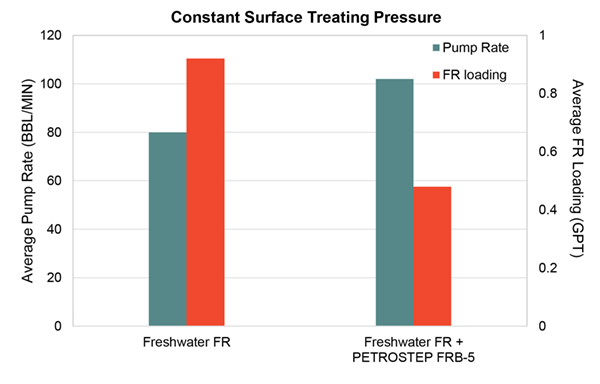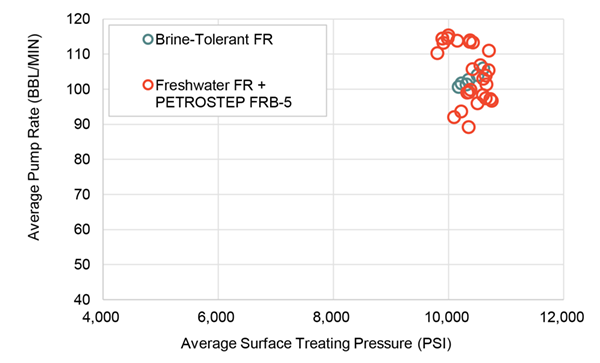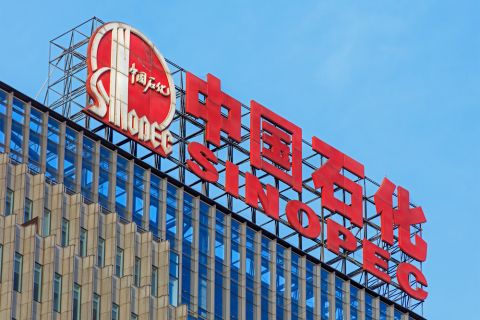Presented by:

Editor's note: This article appears in the E&P newsletter. Subscribe here.
Hydraulic fracturing is a process employed in the oil and gas industry to extract hydrocarbons from formations that would otherwise be uneconomical due to their low permeability. During this process, fracturing fluid is pumped into the formation through a well at high pressures. This causes the formation to fracture, resulting in high permeability pathways for hydrocarbons to flow into the well.
A key component of the fracturing fluid is a high molecular weight charged polymer—friction reducer (FR)— that allows operators to pump fracturing fluid at high rates while keeping surface treating pressures low. Hydraulic fracturing requires millions of gallons of water per well placing considerable strain on freshwater resources. A potential solution to this problem is to reuse the water that is produced along with the hydrocarbons to formulate the fracturing fluid. This water, termed recycled or produced water, contains a large amount of dissolved salts that adversely affect the performance of the FR.
FR manufacturers have developed salt-tolerant FRs, but they are significantly more expensive than the commodity freshwater FRs. Stepan Oilfield Solutions has developed PETROSTEP FRB-5, which enhances the performance of freshwater FRs so they can function optimally in highly saline water. These surfactants reduce the customer’s operating costs by enabling the use of recycled water and improve the sustainability of the fracturing operation by reducing strain on freshwater resources.
Rigorous laboratory testing has demonstrated the efficacy of these surfactant formulations with a wide range of anionic and cationic FRs in brines, some with total dissolved solids (TDS) of more than 250,000 mg/L.
Case study 1
A freshwater FR was used in six slickwater fracturing stages in a well in the Permian Basin. Two stages were completed with the FR alone, while four stages included PETROSTEP FRB-5 at an average concentration of approximately 5% of the FR loading. The mix water contained 90,000 mg/L TDS. The concentrations of the other components of the fracturing fluid—a scale inhibitor and biocide—were held constant throughout. The surface treating pressure was held constant at approximately 8,000 psi to facilitate comparison between stages.
In the stages that employed PETROSTEP FRB-5, the operator was able to increase their pump rates by 25%, while requiring nearly 50% less FR to achieve the same surface treating pressure, resulting in significant operating cost reduction and time savings due to shorter stage durations.

Case study 2
Another field trial in the Permian Basin evaluated the performance of an inexpensive freshwater FR with PETROSTEP FRB-5 compared to a more expensive brine-tolerant FR. The study included 31 fracturing stages in the same well. Six stages were completed using the brine-tolerant FR, while 25 stages employed a freshwater FR with approximately 5% PETROSTEP FRB-5 (relative to FR volume). The mix water contained 110,000 mg/L TDS. The concentrations of the other components of the fracturing fluid were held constant between stages.
The two fluid systems performed comparatively when analyzed over the entire study, even though there were variations in treating pressures and pump rates between stages and wells.

Additionally, the average FR loadings in the two fluid systems were nearly identical. These results enabled the operator to reduce costs by replacing their expensive brine-tolerant FR with an inexpensive freshwater FR enhanced by a small amount of PETROSTEP FRB-5.
Conclusion
Stepan Oilfield Solutions' PETROSTEP FRB-5 surfactant formulations enhance the performance of emulsion-based FRs in brines. They enable operators to formulate their fracturing fluids in recycled and produced waters, resulting in lower costs and more sustainable operations. The surfactant formulations improve the performance of low-cost freshwater FRs to match more expensive brine-tolerant FRs. They also help the operator optimize FR dosage, which minimizes the severity of formation damage from the fracturing fluid.
Recommended Reading
For Sale, Again: Oily Northern Midland’s HighPeak Energy
2024-03-08 - The E&P is looking to hitch a ride on heated, renewed Permian Basin M&A.
CEO: Continental Adds Midland Basin Acreage, Explores Woodford, Barnett
2024-04-11 - Continental Resources is adding leases in Midland and Ector counties, Texas, as the private E&P hunts for drilling locations to explore. Continental is also testing deeper Barnett and Woodford intervals across its Permian footprint, CEO Doug Lawler said in an exclusive interview.
Galp Seeks to Sell Stake in Namibia Oilfield After Discovery, Sources Say
2024-04-22 - Portuguese oil company Galp Energia has launched the sale of half of its stake in an exploration block offshore Namibia.
Chevron Hunts Upside for Oil Recovery, D&C Savings with Permian Pilots
2024-02-06 - New techniques and technologies being piloted by Chevron in the Permian Basin are improving drilling and completed cycle times. Executives at the California-based major hope to eventually improve overall resource recovery from its shale portfolio.
Sinopec Brings West Sichuan Gas Field Onstream
2024-03-14 - The 100 Bcm sour gas onshore field, West Sichuan Gas Field, is expected to produce 2 Bcm per year.




